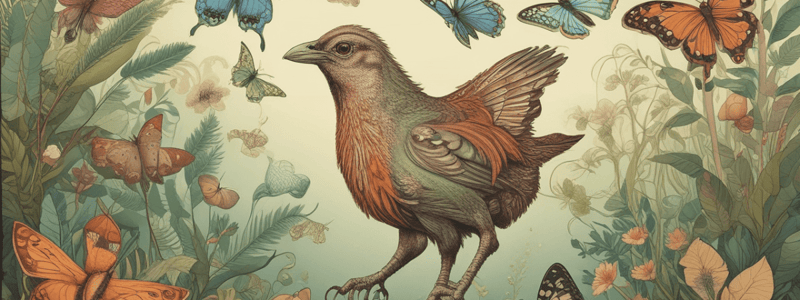Podcast
Questions and Answers
What is the primary mechanism that drives the formation of new species?
What is the primary mechanism that drives the formation of new species?
- Artificial selection and genetic engineering
- Mutation and genetic drift
- Reproductive isolation (correct)
- Natural selection and gene flow
What is the characteristic of a hybrid zone?
What is the characteristic of a hybrid zone?
- A geographic area where members of different species meet and mate (correct)
- A region where reproductive isolation occurs
- An area where species are in a state of punctuated equilibria
- A region where a single species is found
Which type of barrier prevents mating between individuals from different species due to differences in their reproductive structures?
Which type of barrier prevents mating between individuals from different species due to differences in their reproductive structures?
- Behavioral isolation
- Temporal isolation
- Gametic isolation
- Mechanical isolation (correct)
What is the primary mechanism driving sympatric speciation in the Lake Victoria cichlids?
What is the primary mechanism driving sympatric speciation in the Lake Victoria cichlids?
What is the term for the offspring that result from the mating of individuals from two different species?
What is the term for the offspring that result from the mating of individuals from two different species?
What is the term used to describe the process where individuals with certain inherited characteristics are more likely to obtain mates?
What is the term used to describe the process where individuals with certain inherited characteristics are more likely to obtain mates?
Which type of barrier prevents gene flow between different species due to differences in their mating behaviors?
Which type of barrier prevents gene flow between different species due to differences in their mating behaviors?
What is the result of a punctuated pattern in speciation?
What is the result of a punctuated pattern in speciation?
What is the expected diploid chromosome number of a new species formed from the hybridization of two parent species?
What is the expected diploid chromosome number of a new species formed from the hybridization of two parent species?
What is the term for the process by which one species splits into two or more species?
What is the term for the process by which one species splits into two or more species?
What is the main reproductive barrier that normally keeps the gene pools of two species separate?
What is the main reproductive barrier that normally keeps the gene pools of two species separate?
Which type of barrier prevents gene flow between different species due to differences in their breeding seasons or times?
Which type of barrier prevents gene flow between different species due to differences in their breeding seasons or times?
What is an example of temporal isolation in the given text?
What is an example of temporal isolation in the given text?
What is an example of gametic isolation in the given text?
What is an example of gametic isolation in the given text?
What is an example of behavioral isolation in the given text?
What is an example of behavioral isolation in the given text?
What is an example of mechanical isolation in the given text?
What is an example of mechanical isolation in the given text?
What is the result of hybrid offspring of a donkey and a horse, according to the text?
What is the result of hybrid offspring of a donkey and a horse, according to the text?
What is the result of first-generation hybrids of certain species of rice, according to the text?
What is the result of first-generation hybrids of certain species of rice, according to the text?
Flashcards are hidden until you start studying
Study Notes
Speciation
- Speciation is an evolutionary process in which one species splits into two or more species.
The Biological Species Concept
- The biological species concept defines a species as a population or group of populations whose members have the potential to interbreed in nature and produce viable, fertile offspring, but do not produce viable, fertile offspring with members of other such groups.
Reproductive Isolation
- Reproductive isolation is essential for speciation and can occur due to various barriers.
- There are two main types of barriers that maintain reproductive isolation: prezygotic barriers and postzygotic barriers.
- Prezygotic barriers prevent mating or fertilization, while postzygotic barriers prevent the formation of viable or fertile offspring.
Types of Barriers
- Prezygotic barriers:
- Habitat isolation
- Temporal isolation (e.g., different breeding seasons)
- Behavioral isolation (e.g., different mating behaviors)
- Mechanical isolation (e.g., different genitalia shape)
- Postzygotic barriers:
- Hybrid inviability (e.g., hybrid offspring do not complete development or are frail)
- Hybrid sterility (e.g., hybrids are sterile)
- Reduced hybrid fitness (e.g., hybrids have reduced fertility or survival rates)
Sexual Selection and Speciation
- Sexual selection can drive sympatric speciation through mate choice based on specific characteristics.
- For example, mate choice based on male breeding coloration can lead to reproductive isolation in Lake Victoria cichlids.
Hybrid Zones
- Hybrid zones are geographic regions where members of different species meet and mate, producing offspring of mixed ancestry.
- Hybrid zones provide opportunities to study factors that cause reproductive isolation.
Punctuated Equilibria
- Punctuated equilibria refers to a pattern of evolution where long periods of stability are punctuated by sudden changes.
- This concept was coined by Stephen Jay Gould and Niles Eldredge.
Speciation Modes
- Speciation can occur rapidly or slowly, and it can result from changes in few or many genes.
- Speciation can take place with or without geographic separation.
Additional Concepts
- Gene flow can be interrupted in two main ways, leading to speciation.
- Differing directions of particular snail species' shells can prevent complete mating.
- Sea urchin species differ in protein receptors on the egg that bind sperm.
Studying That Suits You
Use AI to generate personalized quizzes and flashcards to suit your learning preferences.



